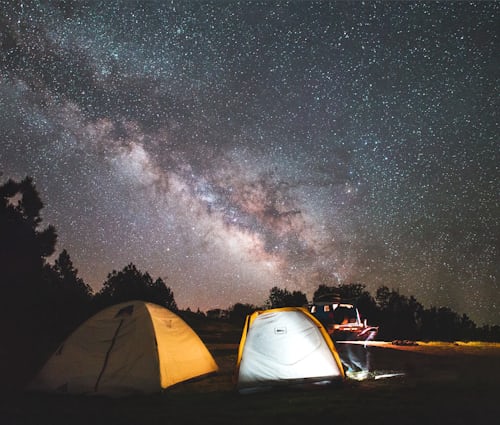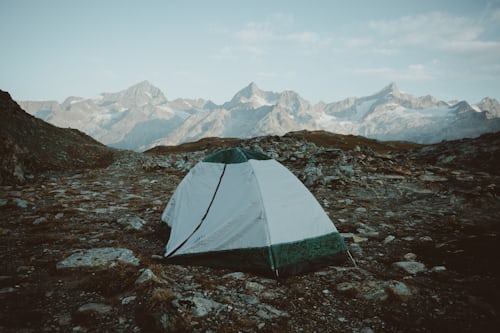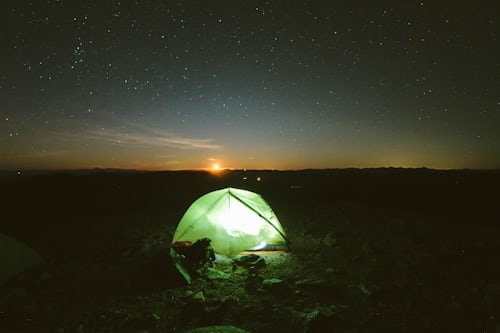
If you’ve slept in a decent tent in a rainstorm, you’ve probably witnessed the wonder that it’s raining down your tent without getting wet. It would be easy to believe that, since most vinyl tents are made of the same materials, they should all be waterproof, but is that the case? Do you know how to make a tent waterproof?
Are tents all waterproof? Although the tents are not really waterproof, the tents differ greatly in degrees of water resistance. The fabric form, density, and thickness of the fabric weave affect the resistance to water, but the consistency of the waterproof coating makes the tent waterproof.
Doing research for this made me know how much a tent goes into weatherproofing! There are many factors that affect the water-resistance of the tent, and so good research is needed to find a tent that will keep you dry.
What Are Waterproof Tents?

So how do you know if the tent is waterproof in the first place? Well, waterproof tents are made of cloth that keeps water out of place, but it seldom lasts forever. The degree to which waterproof tents keep out of the water often differs. However, thankfully, there is a way to compare the waterproofing of various fabrics. Before you learn how to make a tent waterproof, learn what is a waterproof tent?
Waterproof Scores
The Hydrostatic Head (HH) of the tent shows us how well water can be kept out of the tent. It tests how much water the fabric can handle when a column of water is kept above it in millimeters. For example, if a material has an HH of 1000 (1000 HH), it will withstand the pressure of keeping a water column of 1000 mm above it – anything above it, and the water will begin to flow through it. So, the higher the HH value, the greater the water column it can withstand, and the more waterproof the fabric.
When you look at the tents, you can usually find the lowest waterproof level is 1000 HH – anything lower than this is not considered waterproof. While 1000HH is enough to keep you dry in light showers, if you’re going to be out in heavy rain, you’re going to find that this isn’t enough. On the other side, tents with a rating of 3000 HH are designed for torrential rain. Although they’re going to cost more, if you’re going to be out camping in harsh weather, this is the way to go. However, most waterproof tents have a rating of 2000HH, which is ideal for a summer tent of three seasons.
Some fabrics, such as laminates, can achieve a high HH rating on their own – their pores do not allow water to pass through. However, most of the fabrics used in tents are treated with some kind of coating to improve their hydrostatic ranking.
Waterproof Paint
The most popular ones you’ll see are polyurethane (PU) and silicone coatings, which add a thin layer of waterproof film to your tent. These coatings can really improve your HH ranking, but they’re going to add a little weight to your overall tent.
You can also see tents marketed as having a robust water repellent (DWR) finish. This makes hydrophobic fabrics – which means they don’t like water – so they repel water instead of absorbing it. You’ve probably seen this in action if you’ve ever worn a waterproof jacket – the beading of the water droplets on the outside is caused by the hydrophobic repelling of the water. This action mechanism means that DWR finishes work wonders when applied to the outside of your tent and is also much lighter than PU and silicone coatings.
Construction
While high HH rating means that your tent would, in theory, be able to stand up to the elements, this is not always the case. In fact, poorly built HH-rated tents are anything but waterproof. When you’re looking for a tent that’s going to stand up to bad weather, make sure you keep an eye on the seams, the zips, and the flooring, as these are all possible sources of leakage.
Ideally, the seams need to be double-stitched, and the holes need to be covered, and they can also be flipped to avoid leakage. Likewise, the zipper holes will let the water in, so you want to make sure they’re sealed. The groundsheets also have their own HH ranking, so make sure it’s high enough because you want it to be strong enough to stand the test of time. Integrated layouts make it simpler to set up your tent and leave no holes, and now there are so-called bathtub layouts that have elevated edges to limit water intake.
So, a tent that is actually waterproof will have a high HH mark, will most likely be treated with some kind of coating, and will have been cleverly built to keep water out of it.
Is Nylon or Polyester Tent Waterproof?

If you’ve ever used nylon or worn a polyester shirt, you’ve probably spilled water on it before. In any case, nylon and polyester fabrics are not inherently water-resistant.
Polyester fibers do not absorb water like nylon fibers, because the fabrics are only fibers woven close together, and the water can be soaked or drawn to the other side of the cloth, polyester or nylon.
The weave of polyester and nylon has an effect on how much water can move through, and denser fabrics usually stop water better than thinner fabrics of the same kind.
However, one major problem interrupts a weave: the seams. No matter how close a weave is, two fabric pieces are connected to the seams, which ensures that the needle and the thread move through the fabric and ties them together. Seams are the water entry point.
How Are The Nylon Or Polyester Tents Waterproof?

Just like chocolate-dipped ice cream, the secret to waterproofing synthetic materials is the coating. In order to be “waterproofed,” tent fabrics must be covered with either polyurethane, silicone, or DWR (Durable Water Repellant) or even a mixture of both of them.
Many of these coatings will disintegrate over time, so even a very costly tent with all the waterproofing treatment will need to be re-treated if you want to continue to benefit from a dry tent.
- DWR is the lightest treatment of all of these sprays (and therefore will evaporate), Teflon being a recognizable form. The use of DWR is controversial in terms of its environmental effects and overall effectiveness.
- Polyurethane is a synthetic material that is widely used for waterproofing of fabrics (including tents). Usually, the form of polyurethane is either polyester urethane (PU) or polyether urethane (PE), which have similar characteristics with PE having some advantages of durability and lack of water absorbency over PU.
- Silicone is an inert material known for its non stick capacity. It’s extremely waterproof and lasts a long time. Tents are coated with some form of polyurethane or silicone, and both are coated several times.
If you want an overview of the various waterproof coatings as well as a rundown of the advantages and drawbacks, check out this blog post from slingfin.com.
How To Make A Tent Waterproof

Most of the tents are already waterproof when you purchase them. But that doesn’t mean they’re ready to be caught in a rainstorm and blown down on any terrain, and you’re going to have a warm, dry time. You’re not going to. Although these tents have already done a lot of work for us, there are a few more things we can do to make sure they’re ready for the field.
We want to do three things to make our tent fully waterproof. We’re trying to make sure all the ties are close. We’re trying to make sure our Groundcloth is ready. And we’re trying to close the seams. Here’s how to make a tent waterproof!
– Close Ties
On the Rainfly, we’re going to want to make sure the links are secure when they’re put over the shelter. It’s going to be really annoying to do this in the rain, and actually, it can’t be done right, as the rain can make the links say. Do it at home. If the chords aren’t reflective, you may want to buy them and fix them. Not only are these chords easier to see at night, just in case you’re going to have to tweak them at night, but they’re still solid enough to be tied to the Hitch Knot. A Hitch Knot is great for Rainflies as we can change it if we need a lot of time.
– Ground Cloth
Ground cloths are a wonderful feature of a tent, but they can be improved upon. Moreover, ground cloths keep the water out of the tent in the most humid weather. But if it’s getting too wet, the Ground Cloth will actually absorb water and funnel it into your own tent. We want to make sure the seam around the bottom of the tent and the Groundcloth are one. Put the Ground Cloth in the seam and seal it.
You can make an extra patch for the ground cloth if you want to. Take off the ground cloth and weigh it while on the tarp, map it around it. Cut the tarp and sew it in the fabric and seam around the tent. This is only really needed for older tents. Most of the newer tents simply need a ground cloth tucked into the seams and sealed.
– Seal The Seams
Sealing the seams is going to be the hardest part of the operation. You’ll need to seal and waterproof every seam on older tents. You would need to use a sealant on the inside of all the seams to do this, and then let it dry. Then repeat it. After this application is dry, you will need a waterproof spray to cover the outside of the seams and let it dry again.
If you’ve got a newer tent, you’ll see that the seams are Tape Covered. Tape Sealed means that the tape inside is sewn and stitched as a sealant. They won’t have to be waterproofed. But the chances are that the Rainfly seams will still need it on the surface. When using a sealant on these seams, make sure that you do it from the inside of the tent.
Take the tent and turn it inside out to do this. Pull the seams up to expose the stitching. Often, because of the sealant’s chemical qualities, make sure you do this where you can get enough air. If this tent is not brand new, you may need to clean the seams first with a cotton swab and some alcohol. Make sure the seal is full and smooth. Let it dry up, and then do it again.
Taking these steps will make those rainy nights out in the wild so much more relaxed and dry that you’ll be very glad to have done it.
The Benefits Of A Waterproof Tent

Now that you learned how to make a tent waterproof, here are the benefits of having a waterproof tent.The last thing you want to do when you go camping is to sit inside your tent during a rainstorm and still get soaked. While this could never happen to you, it has happened before. That’s why the advantages of waterproof backpacking tents are a perfect list to look at.
1. First Benefit
When you picked your own tent for the first time, you might have thought that one tent is the same as the other, but that’s incorrect. Durability, ventilation, and ease of use are what give the waterproof tents two thumbs up. If you’re planning to camp in the summer or fall of the year, you’ll need to know how much you can count on the waterproof backpacking tents. These tents will make sure you stay dry inside. Fully, this waterproof material isn’t hard on your back either. You get the luxury of knowing that you can make it through the rain with a waterproof backpacking tent.
2. Second Benefit
Compared to the 4 season backpacking tents, we’d say it would be a safe bet that each of these tents will handle the weather, except that the 4 season backpacking tents can handle the snow and other extreme storms. When you’re in the mountains and get caught in a downpour, you can always look around you wherever possible and determine the damage soon after the ground is saturated.
Look for potential mudslides and other life-threatening actions of nature. You can’t control the weather, but you can typically control the situation you’re in. When the rain starts, you will need to search for higher ground. Always bring a rope with you at all times while you camp and use the rope to get around you and all of you so that you can stay together without thinking about being separated.
When the storm leaves, you will enjoy the peace of mind that you gave yourself by taking precautions before the journey. Sometimes the storms come up quickly, but you can be prepared for them.
3. Third Benefit
If you get stuck in a rainstorm, sit where you’re using your signal before someone can find you to save you. The biggest mistake people make when they’re out in the woods is
to keep walking. This could lead you away from the campsite and into danger.
Go over the safety plan for all the people who are with you. Knowing what to expect could make a difference between life and death. Rainstorms are usually not too much to think about, but you do need to be prepared. Purchasing backpacking stoves will make it easier for you to have a meal when you have to cook.
You should fix some soup or warm stuff to get you moving again. It’s also a smart idea to take alone tent backpacking around while you’re searching for firewood. These tents are lightweight and can be set up anywhere if you’re lost. You may also want to invest in a backpacking net shelter. This sort of tent is going to be nice when you’re trying to eat dinner, and it’s beginning to rain.
The netting tent helps you to continue your meal without interruption. Tent backpacking will make camping a great experience. Don’t forget to rest in the tents of the hammock. After a hard storm, it’s time to get home and start relaxing.
Final Words
Are tents waterproof? In short, not absolutely. However, if they’re made in the right way, they can do a pretty decent job of keeping the water out. The best tents will have a mixture of different water-repellent coatings, and they will also have a sturdy structure that leaves no weak spots. When shopping around, keep an eye on the HH ranking, the combination of the coatings used, and check that the seams are sealed, and the zippers are protected. If possible, take a bathtub-style layout, as this is the safest way to avoid the water from entering the ground floor.
But even the best tents will inevitably begin to leak. However, as we’ve seen, this doesn’t mean that your favorite tent is the end of the line. Most leaks can be overcome with some easy maintenance, and testing your tent on a regular basis is the perfect way to make sure you don’t get caught on a rainy camping trip. If you don’t have time to waterproof your tent before you head out, or if you just want some extra coverage, you can always take a tarp with you for some extra protection.
Now you know what makes your tent waterproof, what to keep an eye on when you buy a tent, and how to make your tent waterproof at home – say goodbye to soggy camping trips.